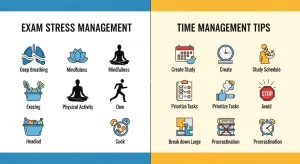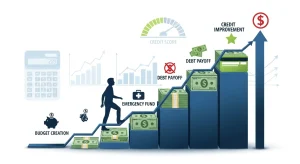Building a secure financial future starts with implementing effective saving money strategies that work for your lifestyle and goals. Whether you’re looking to create an emergency fund, save for a major purchase, or simply gain better control over your finances, the right approach can help you save thousands of dollars annually.
In today’s economic climate, learning how to save money has become more critical than ever. With rising costs of living and economic uncertainty, developing smart budgeting strategies and money saving habits can make the difference between financial stress and financial freedom.
Investing for Beginners: Your Complete Guide to Start Building Wealth in 2025
Why Saving Money Matters More Than Ever
Personal finance management through strategic saving provides numerous benefits that extend far beyond your bank account balance:
- Financial Security: Emergency funds protect against unexpected expenses and job loss
- Goal Achievement: Systematic saving helps you reach major life milestones
- Stress Reduction: Having money set aside reduces financial anxiety
- Future Opportunities: Savings enable you to take advantage of investment opportunities
- Debt Prevention: Strong savings habits reduce reliance on credit cards and loans
Essential Money Saving Strategies for Beginners
1. Create a Comprehensive Budget
The foundation of all effective saving money strategies starts with understanding where your money goes. Smart budgeting involves:
- Track all expenses for at least one month
- Categorize spending into needs, wants, and savings
- Use the 50/30/20 rule: 50% needs, 30% wants, 20% savings
- Review and adjust monthly to stay on track
2. Automate Your Savings
Automatic saving removes the temptation to spend money before saving it:
- Set up automatic transfers to savings accounts
- Use payroll deduction for retirement contributions
- Schedule transfers for the day after payday
- Start with small amounts and gradually increase
3. Cut Monthly Subscriptions and Recurring Expenses
Reducing monthly expenses can free up significant money for savings:
| Expense Category | Average Monthly Savings |
|---|---|
| Streaming services | $30-50 |
| Gym memberships | $40-80 |
| Magazine subscriptions | $15-25 |
| Premium app subscriptions | $20-40 |
Blog Post: Yoga, Breathwork and Sleep Improvement
Advanced Money Saving Techniques
4. Master Grocery Shopping Strategies
Grocery budget optimization can save families $200-400 monthly:
- Plan meals weekly before shopping
- Use coupons and cashback apps like Ibotta and Rakuten
- Buy generic brands for 20-30% savings
- Shop sales and stock up on non-perishable items
- Avoid shopping when hungry to reduce impulse purchases
5. Optimize Your Transportation Costs
Transportation savings represent one of the largest opportunities for reducing expenses:
- Combine errands into single trips
- Use public transportation when available
- Consider carpooling or ride-sharing for work
- Maintain your vehicle properly to improve fuel efficiency
- Walk or bike for short distances
6. Implement Energy-Saving Measures
Home energy efficiency improvements can reduce utility bills by 10-30%:
- Adjust thermostat settings by 7-10 degrees when away
- Use LED light bulbs for 75% less energy consumption
- Unplug electronics when not in use to eliminate phantom loads
- Seal air leaks around windows and doors
- Use programmable thermostats for automatic temperature control
Daily Self-Care Routines: Transform Your 2025 With Simple Wellness Habits
Smart Shopping and Consumer Strategies
7. Practice Strategic Shopping
Frugal shopping habits can dramatically reduce spending without sacrificing quality:
- Compare prices across multiple retailers
- Time major purchases around sales cycles
- Buy seasonal items off-season for maximum discounts
- Use price tracking tools to identify the best deals
- Consider buying quality used items for significant savings
8. Negotiate Bills and Services
Many people don’t realize that bill negotiation can reduce monthly expenses:
- Call service providers annually to review rates
- Ask about loyalty discounts for long-term customers
- Bundle services for package deals
- Threaten to cancel to access retention offers
- Research competitor pricing before negotiations
Mushroom & Adaptogen Skincare: The Ultimate Guide to Fungi-Powered Beauty
Building Long-Term Wealth Through Saving
9. Establish Multiple Savings Goals
Goal-based saving helps maintain motivation and progress:
Short-Term Goals (1-2 years)
- Emergency fund (3-6 months expenses)
- Vacation fund
- Holiday shopping fund
- Home maintenance reserve
Long-Term Goals (3+ years)
- Down payment for home
- Children’s education fund
- Retirement savings
- Investment capital
10. Maximize High-Yield Savings Opportunities
Optimizing savings accounts ensures your money grows faster:
- High-yield savings accounts offering 4-5% APY
- Certificates of Deposit (CDs) for guaranteed returns
- Money market accounts with tiered interest rates
- Treasury bills for risk-free government backing
K-Beauty Favourites: Snail Mucin and Sheet Masks Guide
Technology and Tools for Better Money Management
11. Leverage Financial Apps and Tools
Modern budgeting apps and expense tracking tools simplify money management:
- Mint: Comprehensive budget tracking and bill reminders
- YNAB (You Need A Budget): Zero-based budgeting methodology
- Personal Capital: Investment and net worth tracking
- Acorns: Round-up savings and micro-investing
- Rakuten: Cashback rewards for online shopping
12. Use Cashback and Rewards Programs
Rewards optimization can return 1-5% on regular purchases:
- Credit card cashback programs (pay off balances monthly)
- Store loyalty programs for frequent purchases
- Cashback apps for grocery and retail shopping
- Utility company rewards for energy-efficient appliances
Niacinamide vs Retinol: Which Anti-Aging Ingredient Reigns Supreme?
Lifestyle Changes That Boost Savings
13. Adopt Frugal Living Principles
Frugal lifestyle choices don’t mean living uncomfortably:
- Cook meals at home instead of dining out frequently
- Find free entertainment options like hiking, libraries, and community events
- Repair instead of replace when possible
- Buy quality items that last longer
- Practice minimalism to reduce unnecessary purchases
14. Develop Multiple Income Streams
Increasing income accelerates savings goals:
- Side hustles like freelancing or gig economy work
- Selling unused items through online marketplaces
- Passive income through investments or rental properties
- Skill monetization through teaching or consulting
Common Money-Saving Mistakes to Avoid
Understanding savings pitfalls helps maintain progress:
- Being too restrictive and creating unsustainable budgets
- Not tracking small expenses that add up over time
- Focusing only on big cuts while ignoring daily habits
- Not automating savings and relying on willpower alone
- Saving without clear goals leading to motivation loss
Biohacking and Supplements for Peak Performance
Frequently Asked Questions
How Much Money Should I Save Each Month?
Financial experts recommend saving 20% of your income, but start with whatever you can afford. Even saving $25-50 monthly builds the habit and creates momentum for larger amounts. The key is consistency rather than the initial amount.
What Are the Fastest Ways to Save Money?
Quick money-saving strategies include:
- Canceling unused subscriptions immediately
- Negotiating bills and insurance rates
- Meal planning and cooking at home
- Using coupons and cashback apps
- Switching to generic brands for common purchases
How Can I Save Money on a Tight Budget?
Saving on limited income requires focusing on small, consistent changes:
- Track every expense to identify waste
- Prioritize free or low-cost entertainment
- Use community resources like food banks if needed
- Focus on reducing the biggest expenses first
- Consider the “pay yourself first” approach with automatic transfers
The Ultimate Guide to the Best Workout Apps and Online Classes in 2025
Creating Your Personal Savings Action Plan
Now that you understand various saving money strategies, it’s time to create your personalized plan:
- Calculate your current savings rate and set a target increase
- Identify your top 3 expense categories for immediate reduction
- Automate at least one savings goal this week
- Choose 2-3 strategies from this guide to implement immediately
- Track your progress monthly and adjust as needed
Ready to take control of your financial future?
Money-saving kitchen gadgets (slow cooker, bread maker):
to open a high-yield savings account and start earning more on your money while building your wealth.
Conclusion
Implementing effective saving money strategies doesn’t require dramatic lifestyle changes or earning a six-figure income. By focusing on smart budgeting, expense reduction, and automated saving, anyone can build substantial wealth over time.
The key to successful personal finance management lies in starting small, staying consistent, and gradually expanding your money saving habits as they become second nature. Remember that every dollar saved is a dollar that can work for your future financial security and goals.
Start with one or two strategies today, and you’ll be amazed at how quickly these frugal living principles can transform your financial situation. The journey to financial freedom begins with a single step – and that step is developing the discipline to save consistently.











